
Northern right whale dolphins (Lissodelphis
borealis), bow-riding at night, Monterey Bay.
Part 2: California (continued)
California is the only place where four species of eared seals
(Otariidae) occur together, but the only species most visitors see is California
sea lion.
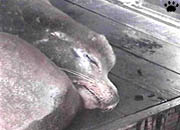 |
 |
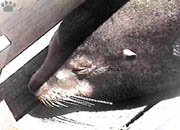 |
| California sea lions
(Zalophus californianus californianus), Monterey. |
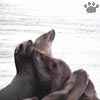 California sea lions,
California sea lions,
Monterey. |
Sea lions regularly haul out in city
harbors, such as in San Francisco and Monterey. They spend most days sleeping
and sunbathing on piers and buoys, and head out to the sea at night to fish. They
can sometimes be encountered hundreds miles from shore, but are much more common
in coastal waters. |
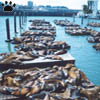
California sea lions,
San Francisco. |

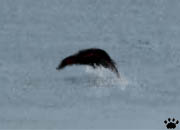
California sea lions at sea,
Monterey Bay. |
Tame on their Central California
haulouts, sea lions are extremly shy in their breeding colonies further South.
In places where they share beaches with other species of pinnipedes, California
sea lions are the ones most prone to panic. Barking loudly, they rush towards
the sea at a slightest sign of danger, often causing their more calm neighbors
to follow, such as in the pictures below. |
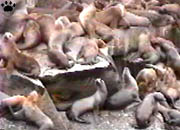 
California sea lions: females (above)
and pup, San Miguel Island. |
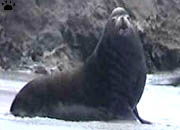 |
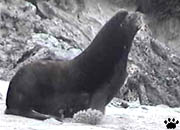 |
 |
| California sea lion and
Northern elephant seal, San Miguel Islands. |
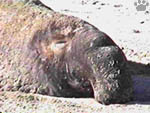
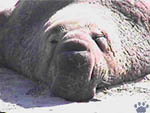
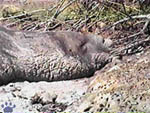
Male elephant seals, Anyo Nuevo. |
Male elephant seals, Anyo Nuevo.
Another popular tourist attraction are the colonies of Northern elephant seals
(Mirounga angustirostris). 
Female elephant seal, Anyo Nuevo.
The best time and place to see them is in February at Anyo Nuevo Point between
Monterey and San Francisco.
Male elephant seals, Anyo Nuevo. |
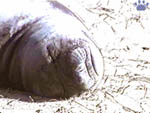


Baby elephant seals, Anyo Nuevo. |
 |
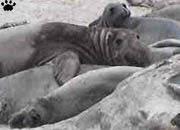 |
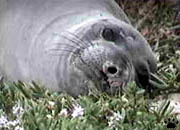 |
| Northern elephant seals
in the dunes, San Miguel Island. |

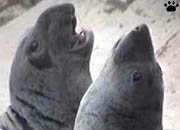
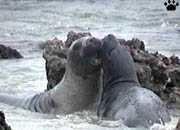
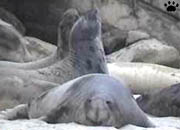

Immature males in playful fights,
San Miguel. |

Elephant seals at night,
San Miguel Island.
Northern elephant seals have a bizzare migration pattern. Some of them move between
California and Alaska four times a year, coming south first to breed, then to
moult.

Elephant seal tracks,
San Miguel Island.
In summer, thousands of them haul out on remote beaches to moult, sleep, and play.

Sleeping elephant seals,
San Miguel Island.
|
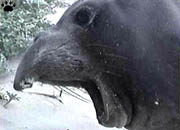
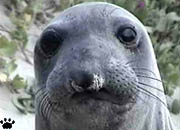



Faces of individual elephant seals
are easy to recognize. San Miguel. |
 |
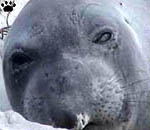 |
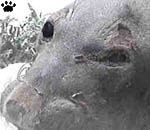 |
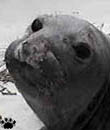 |
| Moulting Northern elephant
seals, San Miguel Island. |
 |
 |
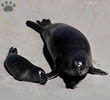 |
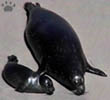 |
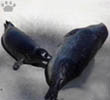 |
| Pacific harbor seals
(Phoca vitulina richardsi), Point Lobos. |
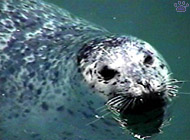 |
The only other true seal in California,
harbor seal, has beautiful, highly variable coloration.

|
 |
| Pacific harbor seals,
Monterey Bay. |
 Friendly sea otter, near
Friendly sea otter, near
Pescadero, California. |
California has a small, but very visible
population of sea otters, considered to be a separate subspecies (Enhydra lutris
nereis). They often live in city harbors and shallow bays, and sometimes approach
people to play with them. They also can spend hours playing with each other, and
this is one of the most charming scenes to see in the ocean. |
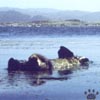 Sleeping sea otter, near
Sleeping sea otter, near
Pescadero, California. |
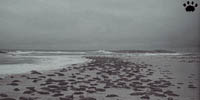
Up to 20,000 seals and sea lions belonging
to up to 6 different species can be seen at
Point Bennett on San Miguel Island. |
The best place
to see marine mammals in Southern California is Point Bennett, the westernmost
point of the Channel Islands. |

California sea lions (brown), Northern elephant
seals (gray), and Northern fur seals (black),
Point Bennett. |

Northern fur seal (right)
and Northern elephant seal,
Point Bennett. |
California sea lions and Northern elephant
seals are the most numerous inhabitants of Point Bennet, but Northern fur seals
(Callorhinus ursinus) also breed here. Steller's sea lions (Eumetopias
jubatus)show up in cold water years, while rare Guadalupe fur seals can sometimes
be seen in years with warm ocean water. |

Guadalupe fur seal
(Arctocephalus townsendii),
Point Bennett. |
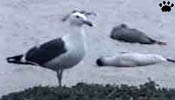
Western gull (Larus occidentalis),
Point Bennett. |
Unfortunately, many newborn pups on
Point Bennet are lost due to predation by seagulls, pollution, and other dangers. |
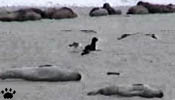
Western gull checking a sea lion pup for
its ability to defend itself, Point Bennett. |
 Looking for vaquitas (Phocoena
Looking for vaquitas (Phocoena
simus) from a beach north from San
Felipe, Baja California. Waters off
El Golfo de Santa Clara in Sonora,
Mexico, should be a better place to
look for them. |
Baja California
has most of the marine mammals found in Alta (American)
California, plus colonies of Guadalupe fur seal on islands off its northwestern
coast, a few tropical species often seen off its southern shores, and the endemic
vaquita, a beautiful tiny porpoise endemic to the northern tip of Sea of Cortez. |
 There are only a few hundred of these
There are only a few hundred of these
porpoises left, so seeing them is very
difficult, and videotaping almost
impossible. Here, a few dorsal fins are
barely visible on the horizon beyond
the Cortez' extensive tidal mudflats. |
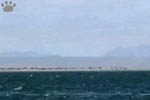 Laguna San Ignacio, Baja California.
Laguna San Ignacio, Baja California. |
Baja's main attraction, however, are
three large lagoons along its southwestern coast, where almost the entire World
population of gray whales comes every winter to breed. They mate and give birth
in shallow waters of the lagoons, and sometimes also in the Sea of Cortez. |
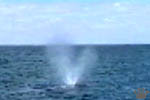 Gray whale, Laguna San Ignacio.
Gray whale, Laguna San Ignacio. |
 Mating gray whales,
Mating gray whales,
Laguna San Ignacio. |
Bahia Magdalena is the warmest, while
Laguna Ojo De Liebere is the most accessible/touristic. The third one, Laguna
San Ignacio, is reached by a 40-mile long and relatively bumpy gravel road, but
it is worth the effort. It is the only place where friendly gray whales regularly
occur. |
 Mating gray whales,
Mating gray whales,
Laguna San Ignacio. |
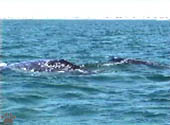
Mother and calf approaching a boat,
Laguna San Ignacio. |

Mother always stays on guard nearby
while its calf is playing with a boat. |

Short whiskers grow in dimples
on a baby whale's head. |

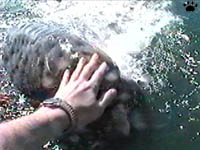
Paying with a baby gray whale,
Laguna San Ignacio. |
Some mothers actively encourage
their newborn babies to approach boats and play with them. The calves particularly
love people to scratch their noses. Whales like it so much that they would often
follow your boat for a few minutes when you finally have to head for the shore
after an hour or two of playing with them. It's good to be a traveling naturalist! |
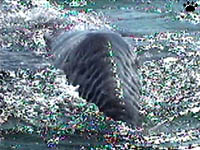

A very small and very inquisitive baby,
not more than a week old, Laguna San Ignacio. |

Blue shark (Prionace glauca), Monterey Bay.
Part 3: North Pacific and Russian Arctic
Back to Part 1
Home
|